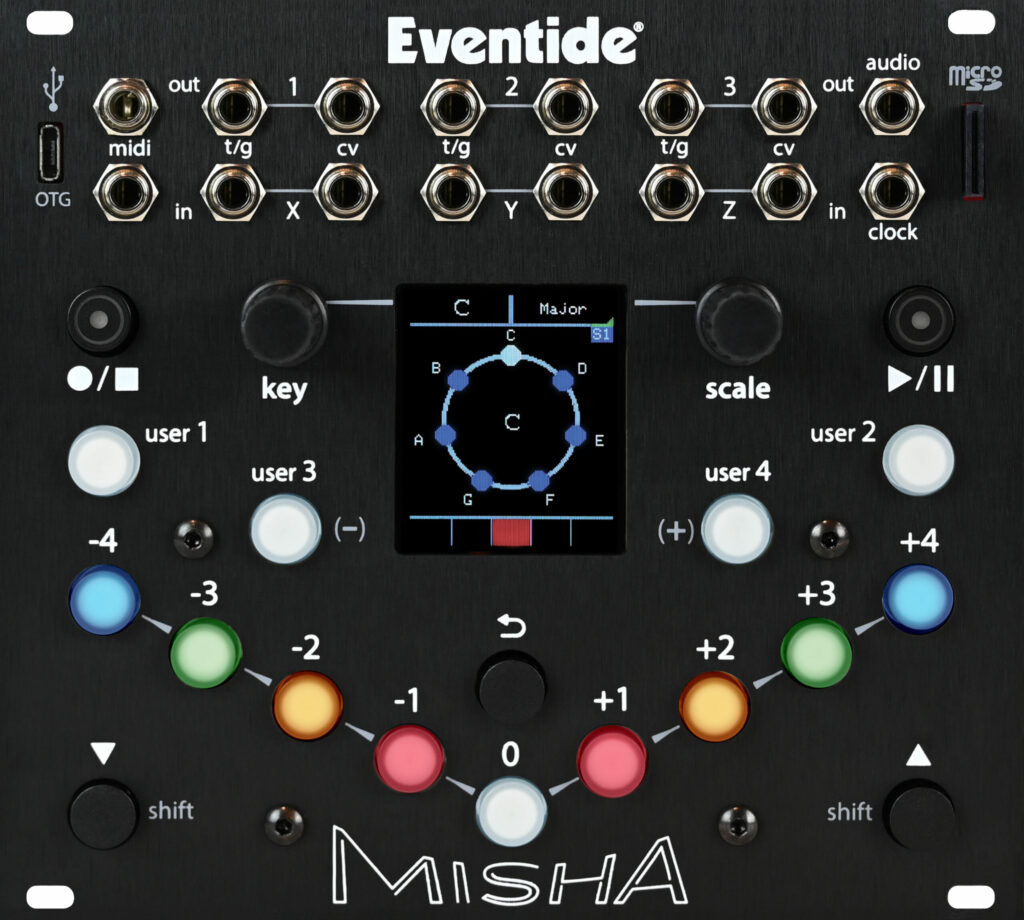Combining real-time performance options with classical composition techniques, Eventide’s Misha is as much a controller as a sequencer. Greg Scarth finds out more.

The Eventide Misha is the legendary New Jersey brand’s second Eurorack offering, following on from the EuroDDL delay released in 2018. While that first module was very much in the brand’s typical wheelhouse, focusing on echo and related effects, Misha is very different. This unusual sequencer/controller/instrument has no real precedent in Eventide’s back catalogue, but it is very much related to other important movements in musical history, adopting an interval-based sequencing approach heavily inspired by twelve-tone serialism (more on that in due course). Unlike most sequencers, it’s designed to help you break out of habits and routines, inspiring new melodic and harmonic patterns whether you’re a trained musician or completely untrained.
Misha is a large module, requiring 28 HP of space in your case despite only having 20 physical controls on the front panel. This isn’t a failure on the part of Eventide’s designers but a deliberate decision to make the module a hands-on experience, designed to be played in real time just as much as it’s designed to be programmed. The V-shaped array of coloured interval buttons is the module’s equivalent of a keyboard, allowing you to play tones. After selecting a key and a scale, it’s a simple case of triggering notes using the interval buttons. Rather than each button corresponding to a given note, each represents a number of steps along the scale from the previously played note. With C Major selected, for instance, pressing 0, 0, 0 would play C, C, C. Pressing 0, +1, +1 would play C, D, E. Pressing 0, +2, -1, +3 would play C, E, D, G. In practice, you find yourself thinking in patterns and logic rather than conventional musical terms. It’s surprising how quickly you adapt to the different approach, particularly in terms of repeating patterns which move in a certain direction, for instance +1, -2, +1, -2 and so on.
So far, it’s all suprisingly intuitive, but there’s a lot more to Misha than the simple performance aspect, as the lengthy 64-page user manual might suggest. Cutting to the chase, Misha is a module which requires you to put in a bit of effort. In stark contrast to a sequencer like ALM’s recently released ASQ-1, which prioritises immediacy and simplicity, Misha allows you to get deeper and deeper into programming and manipulating patterns as you explore further. That becomes obvious when you start to explore the deeper sequencing options which relate to twelve-tone serialism, popularised in the 1920s by composer Arnold Schoenberg. Originally conceived as a way to move away from conventional tonality, this method aimed to use all 12 notes of the chromatic scale equally in a ‘tone row’, without repetition. As it relates to Misha, a tone row can be created from any scale, recorded using the interval buttons and then played back and manipulated either via a trigger input or using the interval buttons to step through the sequence. The pleasing aspect here is how well this approach works for electronic music; it might seem pretentious to apply classical composition techniques to, say, an acid house bassline, but in practice the approach works remarkably well, introducing cyclical movement within a defined framework. It’s here that you can explore ideas like playing tone rows with transformations, such as retrograde (pressing -1 repeatedly to play the tone row in reverse order). Eventide claim that Misha “introduces a new perspective even for a trained musician, but offers the untrained a simple path to creating melodies,” which sounds like a very bold statement until you explore the module and discover that it’s entirely true. The beauty of Misha as a controller or sequencer is that it breaks you away from most conventions of writing or sequencing melodies and harmonies, inspiring new creative approaches. What’s pleasing is just how well that applies to electronic music:

The only aspect of Misha which feels a bit underdeveloped is the ‘instrument’ side of things. Eventide describe the module as an ‘audio instrument and sequencer’, but in truth it’s about 90% sequencer, 10% instrument; the instrument aspect seemingly refers more to the real-time playability than being a fully featured sound source. Misha can generate simple tones internally and you can hear these via the audio output, but you get a lot more versatility if you treat it as a controller/sequencer, triggering other synths over MIDI or CV. The audio output menu offers nothing more than the option to attenuate the output level. Given that Misha is a fully digital module, perhaps there’s scope here for Eventide to expand the synthesis options with a future firmware upgrade. If you’re looking for a fully-fledged synth voice with built-in sequencer, Misha isn’t the answer, but accept that you’ll need to hook it up to other modules and it shouldn’t be a deal breaker.
Misha is an interesting departure from Eventide’s traditional stomping ground, exploring a world completely unrelated to the delays and audio processing tools which made the brand famous. Impressively, it contributes something very exciting to the world of sequencing and Eurorack in general, offering an inspiring approach to melodic sequencing which works well any style of music.
Greg Scarth
More info/buy